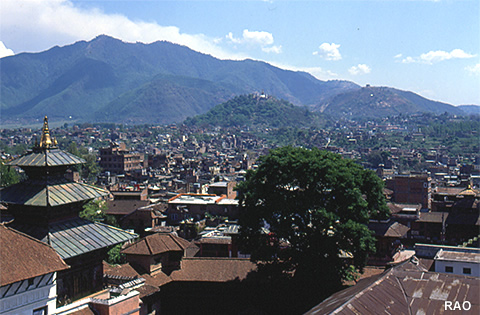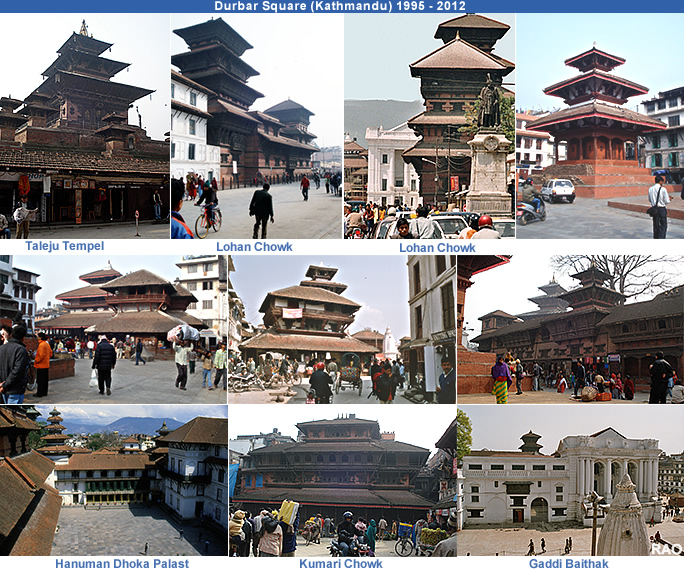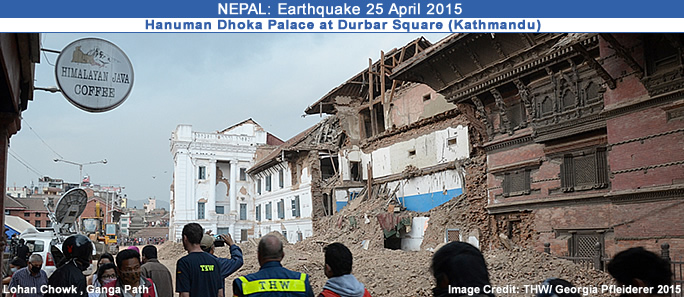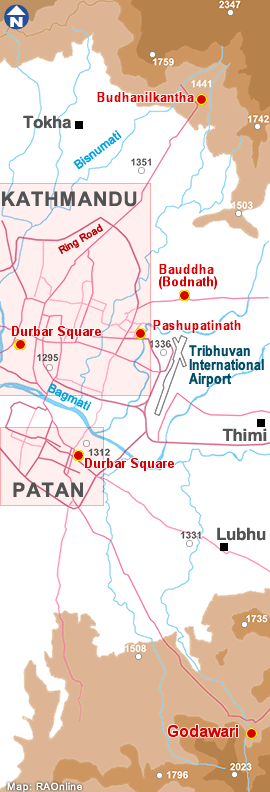 |
Nepal Cities |
|
 |
Nepal Statistics |
|
|
 |
 |
| Kathmandu
Sightseeings |
 |

|
|
Kathmandu:
Indra Chowk |
The Kathmandu
valley is the hub of Nepal for its political, commercial and cultural
activities and is the first stop for the majority of the visitors to the
country.
 |
| Once separate kingdom in itself, it consists of three cities of
the great history. Every one has an artistic exposition of graceful temple,
elegant palace, brick-paved courtyards and quaint streets.
The
history begins with the Buddhist saint Manjushree who slashed a passage
through the surrounding hills to drain out primordial water and made it
habitable. |
|
Over the centuries, a refined urban civilization emerged, built
on a unique synthesis of Hinduism and Buddhism.
Dynasties came and went
trade and the arts flourished. It's deeply religious Newars' inhabitants
built fabulous cities and artistic temples that attracted devout pilgrims
as well as ramping invaders. In the date late 18th century, following the
founding of modern Nepal with in more or less the present boundaries, Kathmandu
was made the capital. It is said that 'Katmandu' was named after Kastamandapan imposing pagoda next to Hanumandhoka palace. The city is said to built
in it's present form by Gunakama Dev 724 AD. Followings are the major tourist
attractions in the Katmandu Valley.
Durbar
Square
This
complex of palaces, courtyards, and temples are built on 12th to 18th centuries
used to be the seat of the ancient Malla kings of Kathmandu. An intriguing
piece here is the 17th century stone inscription set in to the wall of
the palace with writing in15 languages. The Durbar Square protected as
an UNESCO World Heritage Site, is the social, religious and urban focal
point of the city. There are three museums inside the palace building.
| Two ancient courtyards in Hanumandhoka Durbar opened for public |
The Hanumandhoka Durbar Museum Development Committee has opened two ancient courtyards, Mohankali Chowk and Sundari Chowk, in the Hanumandhoka Durbar in Kathmandu for the public, coinciding with the New Year 2012.
Hundreds of Nepali and foreign visitors flocked to the ancient courtyards as they were opened for the public on Sunday.
The Mohankali Chowk was built during the rule of then king Pratap Malla where important meetings would be held. It has intricate woodcarvings and stone carvings. Similarly, the Sundari Chowk also has artistic wooden and stone carving.
The committee said the ancient courtyards were opened for the public to make them aware of their importance.
The Hanumandhoka Durbar square is one of the eight places in the country listed under the UNESCO List of World Heritage Sites. |
| Nepal Tourism Board (NTB), January 2012 |
 |
 |
 |
 |
 |
 |
 |
 |
 |
 |
 |
|
 |
 |
 |
 |
| Narayanhiti
Palace
Narayanhiti
Palace Museum is now open for public. The entry fee is NRs 100 for
Nepalis and NRs 20 for students, NRs 250 for SAARC nationals and Chinese.
Other foreign visitors have to pay at the museum's entrance .
Visitors
can take a look at nineteen different blocks and belongings of the
former royal, e.g. furniture, precious artefacts, wardrobes, the
crown.
Swoyambhunath
Stupa
Swoyambhunath
Stupa is one of the most glorious Buddhist Stupa, which is the
oldest shrine of Kathmandu valley. Visitors often call it 'Monkey Temple'.
The Stupa is formed with a solid hemisphere of bricks and clay supporting
lofty conical spire capped by a pinnacle of copper gilt. Painted on four
sides of the spire are the all-seeing eyes of Lord Buddha. It is three
kilometers west of Kathmandu and located on the hilltop nearly 700 meters
above the sea level of the valley.
Pashupatinath
Temple
One
of then most sacred Hindu shrines of the world, Pashupati
Nath lies 6 km east of Katmandu City center. Is famous for it's
superb architecture with its two tired golden roof and silver doors. It
is a center of annual pilgrimage of Mahasivaratri. The richly ornamented
pagoda houses the sacred LINGA or phallic symbol of Lord Shiva. Chronicles
indicate the temple's existence prior to 400 AD. Devotees can be seen taking
ritual dips in the Holy Bagmati River following beside the temple, also
a World heritage Site.
Boudhanath
Stupa
One
of the world's largest Stupa, Boudha is generally acknowledged to be the most important Tibetan Buddhist monument
outside Tibet. Tibetans simply call it CHORTEN CHEMPO "Great Stupa". It
has now become the Mecca of Tibetan exiles in Nepal. |
|
Walking around Boudhnath
one often fins men wearing long braids wrapped around their heads. Many
of these pilgrims carry their own prayer wheels, which they spin incessantly.
Budhanilikantha
Budhanilikantha is situated below Shivapuri hill at the northern end of the valley. It
is about 10 km from the city venture. The hub of the temple is a pond,
in which lies a great stone figure of the Hindu god Vishnu reclining on
a bed of snakes. It is the 5th century statue during the Lichachhavi period.
Godavari
Situated
at the foothills of Phulchowki, the Botanical Garden of Godavari has splendid natural beauty. The road
from Patan city runs to Godavari to the southeast, passing through the
small old towns of Harisiddhi, Thaiba and Badegaun. The only botanical
garden in Nepal, it s open daily including Saturdays and Government holidays.
In this place, a holy pond known as "Kunda" is located. A fair is held
in every gap of 12 years where most of pilgrims come to take bath. It is
believed that taking bath in the cold water at this holy pond makes one
to free from all the skin diseases. At the top of Godavari the hill named
"Phulchoki", the highest hill of Valley is located with 2,758 m high. It
is a good spot for hiking. A Buddist shrine is situated on the top of the
hill which can be reached through a jeepable road. The VHF tower of Nepal
Television is located at the top of the hill.
 |
An
hour's walk away (3 km) , is the Botanical Garden of Godavari. Located at the foothills of Phulchoki,
one of the highest hills surrounding Kathmandu valley, the garden is landscaped
over 72 hectares of land. Over 500 species of plants can be found in the
various gardens. The peak flowering season falls in spring and in autumn.
The coming of spring is indicated by the bloom of Rhododendron Arboretum,
the national flower of Nepal, and the dramatic appearance of a number of
colourful flowers in the garden beds and the surrounding forests. The gardens
are also the dwelling place for butterflies, Godavari area being a reservoir
for hundreds of species. Maps and plant listings are available at the entrance.
A small admission fee is charged.
Godavari
Springs
Very
close to the Botanical Garden (200 metres away from the main gate) is what is called in Nepali, 'the
Godavari Kunda', a fresh water spring forever spouting forth cool, crystal
clear water. A pilgrimage place revered by both Hindus and Buddhists, the
water is channeled through five carved stone spouts Panchadhara in Nepali)
where pilgrims bathe, drink and worship. There are various temples and
a retreat monastery in the surrounding vicinity. Hindu legend has it that
a certain realized saint, Bahadur Puri Swami, in ancient times used to
walk to the River Godavari in India daily to take a purification bath.
The Goddess being pleased with his devotion, manifested herself at his
doorstep so that he did not have to walk the distance everyday. The Buddhists
believe that the Great Indian mystic, Padmasambhava, who initially introduced
Vajrayana Buddhism in Tibet, while passing through Nepal struck the root
and created the spring in order to symbolize the ultimate truth - always
clear, always fulfilling the thirst of people for supreme knowledge.
top
| More
information and pictures |
 |
 |
 |
External
link |
 |
UNESCO
World
Heritage
|
NEPAL
|
World
Tour
|
| Kathmandu
Valley, Lumbini, Khumbu-Everest, Chitwan |
|
|













